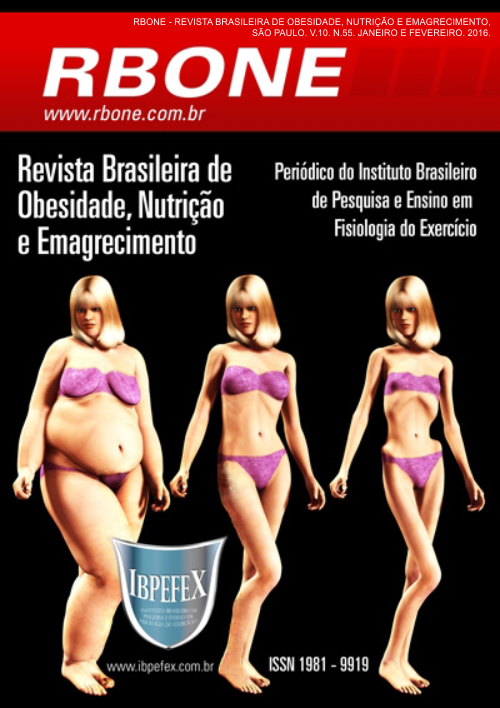Effects of physical exercise to improve the flexibility in knee joint in non sedentaries obeses in comparison to sedentary obeses
Abstract
Flexibility is the maximum passive range of joint movement, one of the main components of physical fitness and health. His influence can reach several aspects of human movement, which highlights the motor improvement, mechanical efficiency, the prevention of injuries, expressiveness and body awareness. Our aim was to evaluate the difference in the degree of flexibilityin the knee joints in obese sedentary and exercised. Identifying possible improvements in the functional capacity of obese exercised and reduced associated pathologies. For this research were evaluated eighteen volunteers of both sexes who had degree of obesity 1. Among the nine patients evaluated are practitioners of physical exercise walk type, with daily practice at least three months and nine sedentary. The individuals trained were recruited in Leisure Square "St. Therese" in the city of Taubaté-SP, and not exercised were recruited inAnhanguera College of Taubaté-SP. The flexibility of the knee flexion was analyzed by goniometry between the two obese groups. Comparing the average found big difference. The inactive obese knee had an average degree of flexibility of 87.75 ± 9.85 degrees with a mean BMI 32.60 ± 0.91 (Figure 3) while the average degree of flexibility of the knee was exercised obese 134 3 ± 2.5 degrees. It is concluded that regular physical exercise plays an important role in rehabilitation strategy of this population, is fundamental in the prevention of orthopedic diseases.
References
-Araújo, C.G.S.; Araújo, D.S.M.S. Flexteste: utilização inapropriada de versões condensadas. Rev. Bras. Med. Esporte. Vol. 10. Num. 05. p. 381-384. 2004.
-Calvete, S.A. A relação entre alteração postural e lesões esportivas em crianças e adolescentes obesos. Motriz. V. 10. Núm. 2. p. 67-72. 2004.
-Carvalho, A.C.G.; Paula, K.C.; Azevedo, T.M.C.; Nobrega, A.C.L. Relação entre flexibilidade e força muscular em adultos jovens de ambos os sexos. Revista Brasileira de Medicina do Esporte. Vol. 4. Num. 1. p. 2-8. 1998.
-Cyrino, E.S.; Oliveira, A.R.; Leite, J.C.; Porto, D.B. Comportamento da flexibilidade após 10 semanas de treinamento com pesos. Rev Bras Med Esporte. Vol. 10. Num. 4. 2004.
-Conte, M. Interação entre VO2máx, Índice de Massa Corporal e Flexibilidade. Revista Mackenzie de Educação Física e Esporte. Vol. 2. Num. 2. p. 23-30. 2003.
-Creamer, P.; Lethbridge-Cejku, M.; Hochberg, M.C. Factors associate with functional impairment in symptomatic knee osteoarthritis. Rheumatol. Oxford. Vol. 39. Num. 5. p. 490-6. 2000.
-Dantas, E. H. M. Alongamento e flexionamento. 5ªedição. 2005.
-Fachini, L.M.; Guimarães, A.C.A.; Simas, J.P.N. Níveis de flexibilidade em adultos obesos participantes de um programa de reabilitação cardiovascular. Rev. Digital. Vol. 10. Núm. 100. 2006.
-Kubo, K.; Kanehisa, H.; Kawakami, Y.; Fukunaga, T. Influence of static stretching on viscoelastic properties of human tendon structures in vivo. J Appl Physiol. Vol. 90. Num. 2. p. 520-527. 2001.
-Miranda, L.B.; Morais, P.D.C. Efeitos do método pilates sobre a composição corporal e flexibilidade. Revista Brasileira de Prescrição e Fisiologia do Exercício. São Paulo. Vol. 3. Num. 13. p. 16-21. 2009.
-Rupps, E.; Haenle, M.M.; Steinacker, J.; Mason, R.A. Physical exercise in southern Germany: a cross-sectional study of an urban population. BMJ Open. Vol.8. Num. 2. p. 1-7. 2012.
-Vaquero-Cristóbal, R.; Martínez González-Moro, I.; Alacid Cárceles, F.; Ros Simón, E. Strength, flexibility, balance, resistance and flexibility assessment according to body mass index in active older women. Rev Esp GeriatrGerontol. Vol. 48. Num. 4. p. 171-6. 2013.
-Vasconcelos, K.S.S.; Dias, J.M.S.; Dias, R.C. Relação entre intensidade de dor e capacidade funcional em indivíduos obesos com osteoartrite de joelho.Rev. Bras. fisioter. Vol. 10. Núm. 2. 2006.
Authors who publish in this journal agree to the following terms:
- Authors retain the copyright and grant the journal the right of first publication, with work simultaneously licensed under the Creative Commons Attribution License BY-NC which allows the sharing of the work with acknowledgment of the authorship of the work and initial publication in this journal.
- Authors are authorized to enter into additional contracts separately for non-exclusive distribution of the version of the work published in this journal (eg, publishing in institutional repository or book chapter), with acknowledgment of authorship and initial publication in this journal.
- Authors are allowed and encouraged to post and distribute their work online (eg, in institutional repositories or on their personal page) at any point before or during the editorial process, as this can bring about productive change as well as increase impact and impact. citation of published work (See The Effect of Free Access).






